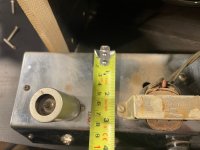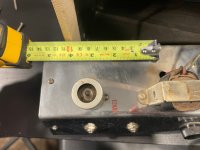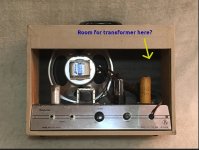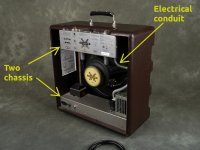Hey all, I picked up an old Airline amp (9021A which I believe is the Supro 6611 circuit) and opened it up to replace the death cap and power cable. Well it seems someone had already taken out the death cap (thankfully) so I ran a three wire IEC in and grounded to the chassis since the only transformer seems to be for the speaker. The amp fires up but has a crazy sounding modulation/distortion when played (and even without signal). If I use an electrical ground lift that goes away and it sounds fine. I'm wondering if anyone has some advice on where to move the ground to.
Thanks a lot!
Thanks a lot!
Is this a 50L6 amp?Supro 6611 circuit .... the only transformer seems to be for the speaker.
If so: This is a DEATHTRAP. It NEEDS a power isolation transformer to be non-lethal.
This is a mostly-HiFi forum, where hot-chassis amps are rare (and were banned until recently). I think you should be on a tube guitar amp forum where folks deal with these amps with trepidation but also with knowledge.
Please do NOT lift the ground of this circuit. Lifting the ground could kill you. You can be electrocuted simply by touching the strings of the guitar. Please take this warning seriously.If I use an electrical ground lift that goes away and it sounds fine.
As PRR said, this is a deathtrap. Please don't let it kill you.
There is no safe way to operate the amplifier in its present configuration. It is a deathtrap, and it will remain a deathtrap wherever you move the ground.I'm wondering if anyone has some advice on where to move the ground to.
Please do not plug it in again, until you've implemented the following fix (you are already half-way there with your newly installed IEC socket):
The fix: purchase and mount a 1:1 mains isolation transformer inside the chassis. AC live (suitably fused) and neutral go to the transformer primary winding. The transformer secondary feeds the amplifier circuitry. You've already installed the IEC socket, so use that to ground the amplifier chassis (which is also electrically connected to the strings of your guitar via the guitar cable and metal bridge of your amplifier).
Make sure the metal transformer frame is also grounded to the chassis properly.
A suitable mains isolation transformer doesn't have to be expensive:
1) A Triad N68-X is under $20 USD at Digikey. If your amp draws less than 50 VA, it will do the job: https://www.digikey.com/en/products/detail/triad-magnetics/N-68X/1887210
Note that the N68-X has two primary windings. Put them in parallel for your purposes (120V: 120V isolation transformer). Phasing matters (bad things happen if you wire one of the two primaries the wrong way around!). There's a link to the datasheet on that Digikey page, and the datasheet shows you what colour wires to connect together.
2) A Triad N76-U costs just under $41 USD, and can supply up to 100 VA (you probably don't need that much): https://www.digikey.com/en/products/detail/triad-magnetics/N-76U/4915286
-Gnobuddy
Thanks so much all! It's been on the shelf but will get the transformer ordered and appreciate the help.
One question if anyone has the time, do you know of any smaller isolation transformers? I'm currently googling but have a maximum of 2" in one direction to mount it to the amp chassis which is unfortunately too narrow for that Triad one unless I can mount it to the side and run the cabling in.
Thought I got email notifications about the responses which I apparently missed, thus the long delay on this.
Thought I got email notifications about the responses which I apparently missed, thus the long delay on this.
Attachments
A quick look at Digikey didn't turn up any physically smaller isolation transformers.
Can you mount the isolation transformer to the inside of the wooden cab, rather than to the existing metal chassis? Or alternatively, cut and add a piece of metal sheet to the existing chassis to carry the transformer?
-Gnobuddy
Can you mount the isolation transformer to the inside of the wooden cab, rather than to the existing metal chassis? Or alternatively, cut and add a piece of metal sheet to the existing chassis to carry the transformer?
-Gnobuddy
Attachments
Yeah I think mounting it to the inside of the cab is going to be the simplest way to go. Have more grommets to feed the cables down into the chassis so will take a look again and see about getting that setup.
There were some early guitar amplifiers that had two separate chassis in one cab. One chassis carried the power transformer (and usually the power amp), and an internal power cable carried high-voltage DC to the second chassis (which usually held the preamp and all its controls).
I've never seen the original vintage amps with this design, but about a decade ago Fender released their Excelsior amplifier, which was a homage to one of these old vintage amps. In the Excelsior, Fender addressed modern-day safety concerns by using a short length of flexible metal conduit to connect the two chassis, with the high-voltage wires tucked safely inside the conduit.
As long as nobody goes poking around inside the cab with a pair of sharp scissors while it's plugged in (!) I'm not sure the conduit is actually necessary, but it may be something to consider.
One more thing to consider: if you have to run power cables from chassis to (cab-mounted) mains transformer, it might be convenient to be able to disconnect them so that you can remove the two items separately for service. This will require safe and dependable electrical connectors.
If you go this route, my suggestion is to take a look at Anderson Powerpole connectors. They are used in many high-end control panels, and are superbly designed for their job. Each connector consists of an insulating shell, and a separate metal contact, which you crimp or solder onto the wire end, then insert into its shell. For your purposes, 15-amp contacts and matching shells will be more than adequate, though beefier 30-amp contacts fit into the same shells.
I'll attach a pic of an Excelsior.
-Gnobuddy
I've never seen the original vintage amps with this design, but about a decade ago Fender released their Excelsior amplifier, which was a homage to one of these old vintage amps. In the Excelsior, Fender addressed modern-day safety concerns by using a short length of flexible metal conduit to connect the two chassis, with the high-voltage wires tucked safely inside the conduit.
As long as nobody goes poking around inside the cab with a pair of sharp scissors while it's plugged in (!) I'm not sure the conduit is actually necessary, but it may be something to consider.
One more thing to consider: if you have to run power cables from chassis to (cab-mounted) mains transformer, it might be convenient to be able to disconnect them so that you can remove the two items separately for service. This will require safe and dependable electrical connectors.
If you go this route, my suggestion is to take a look at Anderson Powerpole connectors. They are used in many high-end control panels, and are superbly designed for their job. Each connector consists of an insulating shell, and a separate metal contact, which you crimp or solder onto the wire end, then insert into its shell. For your purposes, 15-amp contacts and matching shells will be more than adequate, though beefier 30-amp contacts fit into the same shells.
I'll attach a pic of an Excelsior.
-Gnobuddy
Attachments
- Home
- Live Sound
- Instruments and Amps
- Airline 62-9021A Tube Amp Grounding Question



